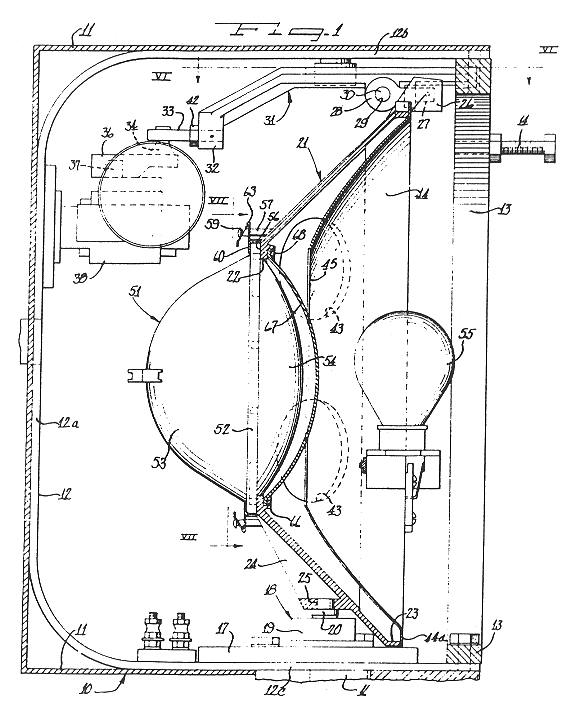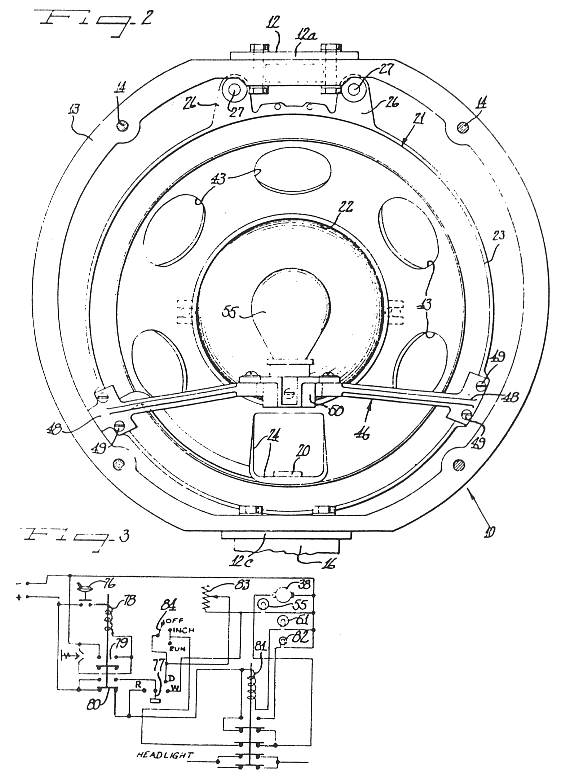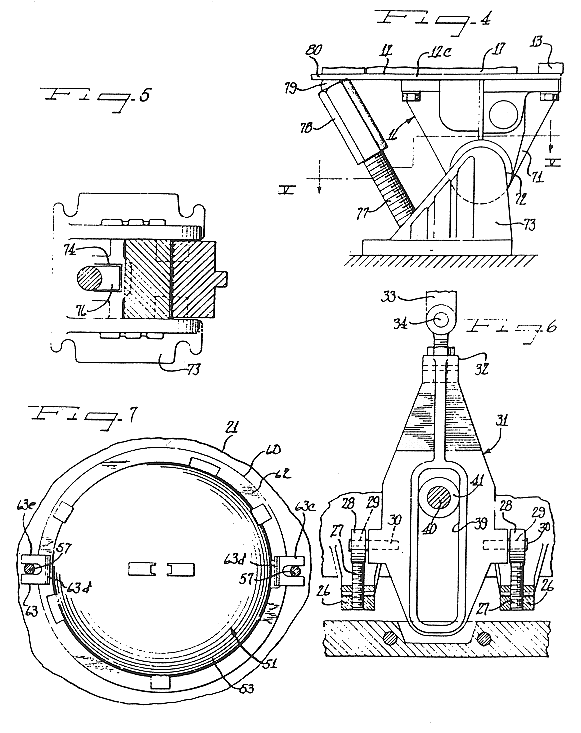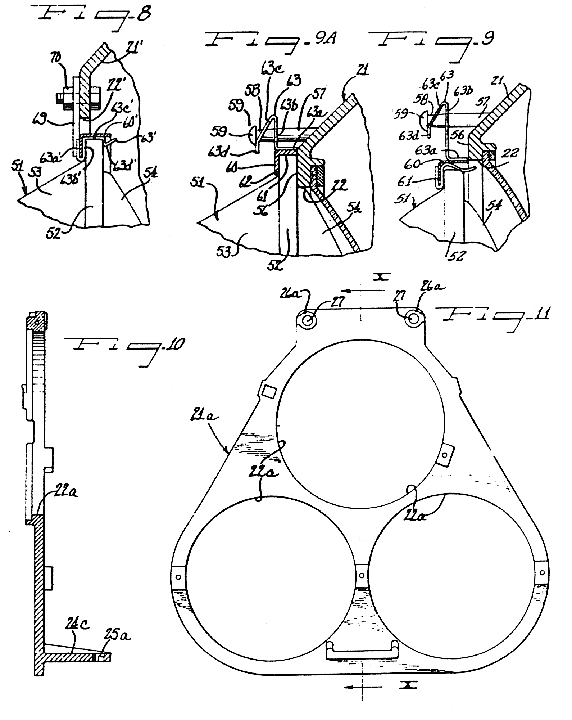This website has been archived from TrainWeb.org/gyra to TrainWeb.US/gyra.
This website has been archived from TrainWeb.org/gyra to TrainWeb.US/gyra.




This invention relates to the provisions of a warning light comprising a reflector member having a curved reflective surface to collect and focus rays of light into the form of a beam of light and having a centrally disposed aperature formed therein. An electric light bulb is provided at the focal point of the reflective surface so that rays of light emanating therefrom will be collected and focussed by the reflective surface and will be projected in a forward direction in the form of a beam of light.
In the centrally disposed opening is provided a sealed beam lamp of the type comprising a glass envelope having its own filament and reflective surface. The sealed beam lamp will project a second beam of light in common with the first mentioned beam of light and substantially coaxial therewith. Circuit means are provided to selectively energize either the sealed beam lamp or the electric light bulb.
This invention further provides for a movable support means carrying the sealed beam lamp and the reflector member so as to adjust the direction of beam projection.
An electric motor may be provided with a driving connection to the support means so as to continuously oscillate the support means, thereby projecting either or both beams of light along a movable path in order to develop a motion pattern.
Since the sealed beam lamp and the electric light bulb, together with its associated reflector comprise two seperate light sources, a color screen could be used for interrupting the light rays emanating from one of the light sources, whereby a colored beam of light will be projected whenever the specific light source is energized. For example, a color screen is provided over the sealed beam lamp so that a colored beam of light will be projected whenever the sealed beam lamp is energized.
An alternate form of the invention uses an apertured plate on which a plurality of sealed beam lamps are mounted instead of the reflector with its accompanying incandescent bulb.
Retaining mechanisms for the sealed beam lamp are also described which will position the sealed beam lamp in proper focal alignment and in firm assembly with the support means without requiring the use of soft gaskets or without requiring an expensive and complicated retaining mechanism necessitating the use of tools or requiring the attention of experienced personnel for servicing and replacement purposes.
Figure 1 is a cross-sectional view with parts shown in elevation and parts removed
for clarity
Figure 2 is a front elevational view with parts removed of the warning light shown
in Figure 1.
Figure 3 is a schematic circuit diagram illustrating one control system which may
be utilized in connection with the warning light.
Figure 4 is a side fragmentary elevational view of the position adjustment locking
means for the warning light.
Figure 5 is a cross-sectional view taken substantially on line V-V of Figure
4.
Figure 6 is a fragmentary cross-sectional view with parts shown in elevation taken
substantially on the line VI-VI of Figure 1.
Figure 7 is a fragmentary cross-sectional view with parts removed taken
substantially on line VII-VII of Figure 1.
Figure 8 is a fragmentary elevational view showing an alternate embodiment of a
retaining mechanism for the sealed beam lamp 51 in this warning light.
Figure 9 is a fragmentary cross-sectional view with parts shown in elevation
illustrating additional details of construction of the sealed beam retaining mechanism shown in
Figure 1.
Figure 9a is an alternative embodiment of the structure of Figure 9.
Figure 10 is a cross-sectional view taken substantially on line X-X of
Figure 11.
Figure 11 is a front elevational view of the modified support plate which can be
used in place of the reflector 44 with bulb 55.
The warning light of this invention is generally indicated by the reference numeral
10 and comprises a casing 11 open at one end and receiving in firm assembly
therewith a frame bracket 12 comprising a strip form member bent to provide a "U-
shaped" frame having a center body portion 12a, an upper leg portion 12b and
a lower leg portion 12c, the leg portions 12b and 12c extending in a
general parallel spaced relatiionship to one another toward the open end of casing 11.
An annular front ring 13 is carried by the frame bracket 12 and includes
an adjustable positioning stud 14 which together with a pedestal support 16
may be utilized to adjust position of the warning light 10 in the place of its use, for
example, at the front end of a locomotive.
On the bottom support leg 12c is provided a mounting plate 17 carring a pivot means taking the form of a universally rockable bearing 18. The bearing 18 comprises an outer housing 19 enclosing suitable bearing races and supporting and centering for universal tilting movement by bearing stud 20.
Extending between the upper leg 12b and the bottom leg 12c is a lamp support plate 21. In the embodiment of Figure 1, the lamp support plate 21 comprises a dish-shaped annular member having a centrally disposed opening 22 and including and outer peripheral rim section 23. There is further provided a rearwardly protruding support boss 24 aperatured as at 25 to receive the bearing stud 20 whereby the lamp support plate 21 will be supported for universal pivoting movement.
Making reference to Figures 1, 2, and 6, it will be noted that toward the top
of the lamp support plate 21, there is provided a pair of spaced boss portions
26 each suitably threaded to receive in assembly therewith the correspondingly
threaded portions of a pair of studs 27, each provided on one end with an eye portion
28 suitably aperatured as at 29 to areceive a pin 30 extending there-
between.
The ends of each of the pins 30 are made secure in opposite sides of a link arm
or lever arm 31 extending rearwardly in spaced relationship to the upper leg
12b.
The link arm 31 terminates in a boss portion 32 receiving the end of a
rod end bearing 33 pivotally connected to a crank arm 34 carried by an
eccentric member 36 rotated by power takeoff shaft 37 of an electric motor
38 mounted on the body portion 12a of the frame bracket member
12.
As shown in Figure 6, the link member 31 is provided with an elongated slot 39 which extends in a generally parallel relation to the leg 12b of the frame bracket 12. Attached to the leg 12b is a pin 40 carrying a bearing member 41 received in the slot 39 and engaging the walls thereof so as to effectively restrain the ambit of motion of the link arm 31 and, hence, the oscillatory movement of the lamp support plate 21.
The rod end bearing member 33 can be selectively adjusted and locked in adjustment by the lock nut 42 (Figure 1) thereby adjusting the effective length of the linkage connection between the drive motor 38 and the support plate 21 so that oscillatory movement of the plate 21 will correspond to a generally conical motion pattern or different sizes of elliptical or modified elliptical motion patterns.
As may be seen in Figures 1 and 2, the support plate 21 is provided with a plurality of circumferentially spaced lightening holes 43. Inwardly of the support plate 21 is provided a curved reflector member 44 which is of a general annular configuration so as to provide a centrally disposed aperature or opening 45 in register with the opening 22.
The reflector member 44 may conveniently take the form of a fragment section of a parabolic reflector having an opening formed at the centrally disposed portion thereof to provide the aperature 45. With such provision, the parabolic surface will form a curved reflector surface to collect and focus the rays of light into the form of a beam of light for projection outwardly of the lamp housing.
As shown in Figure 2, there is also provided in assembly with the support plate 21 a bracket member 46 which extends across the lower portion of the support plate 21 and includes boss portions 48 on opposite ends thereof through which may be passed fasteners indicated at 49 for placing the bracket member 46 in firm assembly with the support plate 21.
At the center of the bracket member 46 is provided with a socket housing 50 receiving an incandescent lamp bulb 55. It will be understood that the bracket member 46 and the positioning thereof on the support plate 21 is so aligned as to locate the source of illumination provided by the incandescent bulb 55 approximately at the focal point of the reflector member 44.
Positioned in the opening 22 of the support plate 21 is a sealed beam lamp 51 of the type comprising a glass envelope having its own filament and its own reflective surface. As shown in Figure 1, the sealed beam lamp 51 includes an annular glass support flange 52 located medially between a rearwardly projecting curved portion 53 and a forwardly projecting curved potion 54. The forwardly projecting portion 54 is preferably of clear glass and forms a lens for the sealed beam lamp while the rearwardly curved portion 53 is adapted to form the reflective surface for the sealed beam lamp. The flange 52 provides support medium for the lamp 51.
An improved retaining structure is shown in Figures 1, 7 and 9, for the sealed beam lamp 51.
First, it will be noted that the lamp support plate 21 provides an annular abutment
surface 56 which surrounds the opening 22 and against which one face of the
flange 52 on the sealed beam lamp 51 may engage as in the alternative
arrangement of Figure 9a. At diagrametrically opposed portions of the opening
22 are provided post members 57 which project generally axially of the
opening 22 and in the orientation of the present disclosure to the rear of the support
plate 21. Each of the posts 57 is generally of uniform cross-section along the
length thereof, however, a portion near one end as indicated at 58 is slightly tapered in
converging direction and terminates in an enlarged head portion indicated at 59.
An annular flange retainer ring 60 includes a first leg 61 concentric with
the flange 52 of the lamp 51 and a second leg 62 axially thereof.
In Figure 9a the leg 61 overlies the flange 52 of the sealed beam lamp 51 and a second leg 62 abuttingly engages the opposite face of the flange 52 in opposed relation to the abuttment surface 56 on the lamp support plate 21.
Projecting radially outwardly of the flange retainer ring 60 in arrangements of Figures 9 and 9a are a pair of circumferentially spaced spring clip members indicated at 63. The spring clip members 63 preferably take the form of a strip form member bent to provide a first leg 63a firmly assembled by spot welding or some other fastening means to the retainer ring 60 and a second leg 63b bent at right angles to the leg 63a and a third leg 63c bent to form together with the leg 63b a pair of angularly intersecting legs providing an acute included angle therebetween. The end of the leg 63c terminates in a flat portion 63d which is generally parallel to the leg 63b and which constitutes a finger manipulable section to flex the leg 63c against the inherent resilience thereof toward the leg 63b.
As is clearly shown in Figure 7, the strip form spring clip member 63 is
provided with an elongated slot 64 which extends through substantial portions of both
legs 63b and 63c and which is of sufficient width to receive the reduced neck
portions 58 of corresponding post member 57. By virtue of such provision,
there is an open recess at the apex portion between the legs 63b and 63c
which receives post 57 whereupon the leg 63c can be resiliently displaced and
snapped in behind the enlarged head portion 59, to place the ring 60 in firm
assembly with the support plate 21.
In Figure 9a, the spring clip member 63 clamps the flange 52
between the engagement surface 56 and the legs 62 of retainer 60.
Note: The following contains unlabeled numerals
To fasten the lamp 51 to the ring 60, circumferentially spaced clips
65 are provided, each comprising a strip form member having spaced legs 65a
and 65b, clamping its leg 61 and having spring finger 65c for
clamping the flange 52 of the lamp 51.
An annular rim portion 66 is provided on the support plate 21 opposite the abutment surface 60 and provides a recess for seating the flange of a dish-shaped color screen 67. Suitable retainer means such as is indicated at 68 are provided to retain the color screen 67 in firm assembly with the support plate 21 thereby to intercept the beam of light projected by the sealed beam lamp 51. In adapting the unit 10 for use as a warning light on vehicles, it is desirable that the color screen 67 take the form of a red translucent article made of glass or plastic so that the beam of projected light may be colored for warning purposes.
In Figure 8, an alternative form of sealed beam lamp retaining means is provided.
In this form of the invention, the lamp support plate 21' is provided with an opening
2' and the flange retainer ring 60' carries in firm assembly therewith a plurality
of circumferentially spaced spring clip members 63'. Each spring clip member
comprises a strip form member having a leg 63a' underlying the annular retainer
member 60', a spaced parallel leg 63b' overlying the same leg portion of the
retainer member 60', a third leg portion 63c' at right angles thereto and a
radially inwardly offset lug 63d'. With the arrangement thus provided, the sealed beam
lamp 51 is merely pushed into the retainer ring 60' and the flange 52
snaps in in behind the retainer lug 63d' so as to be clamped in firm assembly with the
retainer ring 60'.
A plurality of circumferentially spaced lugs 69 can be provided on the back side of
the retainer ring 60' and are assembled to the support plate 21 by suitable
fasteners indicated at 70.
In the event it is desired to utilize the lamp construction thus far described with sealed beam
lamps only instead of with a seperate reflector 44 and incandescent bulb 51,
the arrangement of Figures 10 and 11 may be effectively utilized. In this
embodiment of the invention, a support plate 21a is provided having a plurality of
openings 22a, each adapted to receive a sealed beam lamp. As will be noted upon
referral to Figure 11, there are three openings 22a, the two bottom openings
being aligned on a common centerline axis and the third opening being located superjacent the
two bottom openings so as to form essentially a triangular disposition.
The support plate 21a is provided with a boss portion 24a apertured as at
25a to receive the tiltable post 20 (Figure 1) of a universal bearing as
described above. The plate 21a is further provided with boss portions 26a
suitably apertured to receive the studs 27 so that all the sealed beam lamps mounted in
the respective openings 22a may be oscillated.
In Figures 4 and 5, the pedestal mount 16 is shown in greater
detail and includes a bracket member 71 which provides a pivot connection as at
72 with a support bracket 73. The support bracket 73 has a
rectangular recess 74 receiving a conformably shaped end 76 of a threaded
stud member 77. The threaded stud member threadedly engages an adjustment cap
78 having a boss 79 on the end thereof received in a recess provided on the
underside of the frame bracket 12, as at 80.
When the support bracket 73 is mounted on a supporting structure such as a
locomotive, threaded adjustment of the cap 78 with respect to the stud 77 will
pivotally hinge the frame bracket 12 around the pivot axis as at 72 until stop
member 14 engages a cooperating portion of the support structure such as the
locomotive, thereby wedging the frame bracket 12 in firm adjusted position.
With the provisions of this invention, either the incandescent bulb 55, or the sealed beam lamp 51 may be seperately or concurrently energized, together with the motor 38, whereupon a beam of light will be projected outwardly of casing 11 selectively characterized as to color.
Note: Figure 3 does not appear correct.
In Figure 3 a control circuit is shown for controlling the energization of the bulb
55, sealed beam lamp 51 and motor 38. The control circuit includes
a pressure-responsive switch 76 and also a selector switch 77.
Assuming that the control circuit and warning light 10 are to be employed on a
vehicle such as a railroad locomotive, the pressure-responsive switch 76 will be
connected to the air brake system so that application of the brakes will result in a change in air
pressure in the brake line whereupon the pressure-responsive switch 76 will be actuated
to close the contacts thereof. A relay 78 will be energized and will close switches
79 and 80. When the switch 79 closes, a holding circuit to the relay
78 will be completed so that the relay 78 will remain energized.
When the switch 80 closes, the relay 81 will be energized completing the
circuits to the motor 38 and sealed beam lamp 51 so that a moving beam of
colored light will be produced. A pilot light 82 is also provided which will be energized
to indicate energization of the motor 38 and the sealed beam lamp 51.
A dimming control resistance 83 is also provided in the circuit with the bulb 55
so the intensity of the light may be selectively dimmed. A control switch 84 is also
provided to momentarily energize the motor 38 at the "inch" position or energize the
motor 38 for steady operation at "run".
If manual control is desired, the selector switch 77 may be moved between
positions "R" and "W" corresponding to the "Red" position and the "White" position wherein either
sealed beam lamp 51 or the bulb 55 are energized, respectively.
| 20750/20770/20775/20795 Gyralites: | photos (20750) | photos (20775) | spec. sheets |
|---|